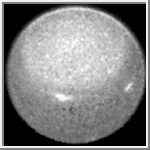|
COMETS EARTH JUPITER KUIPER BELT MARS MERCURY METEORITES NEPTUNE OORT CLOUD PLUTO SATURN SOLAR SYSTEM SPACE SUN URANUS VENUS ORDER PRINTS
PHOTO CATEGORIES SCIENCEVIEWS AMERICAN INDIAN AMPHIBIANS BIRDS BUGS FINE ART FOSSILS THE ISLANDS HISTORICAL PHOTOS MAMMALS OTHER PARKS PLANTS RELIGIOUS REPTILES SCIENCEVIEWS PRINTS
|
Related Document
Download Options
These three NASA Hubble Space Telescope images of the planet Uranus reveal the motion of a pair of bright clouds in the planet's southern hemisphere, and a high altitude haze that forms a "cap" above the planet's south pole. Hubble's new view was obtained on August 14, 1994, when Uranus was 1.7 billion miles (2.8 billion kilometers) from Earth. These atmospheric details were only previously seen by the Voyager 2 spacecraft, which flew by Uranus in 1986. Since then, detailed observations of Uranus's atmospheric features have not been possible because the planet is at the resolution limit of ground-based telescopes. Hubble's Wide Field Planetary Camera 2 observed Uranus through a filter that is sensitive to light reflected by a pair of high altitude clouds. This makes a high altitude haze over Uranus' south polar region clearly visible, along with a pair of high altitude clouds or plume-type features that are 2500 and 1800 miles (4300 and 3100 kilometers) across, respectively. This sequence of images shows how the clouds (labeled A and B) rotate with the planet during the three hours that elapsed between the first two observations (left and center picture) and the five hours that elapsed between the second pair of observations (center and right picture). Some cloud motion might be due to high altitude winds on the planet. (Observations are indicated in Universal Time.) By tracking the motion of high-altitude clouds, the new Hubble observations will allow astronomers to make new measurements of Uranus' rotation period. Based on the previous Voyager observations, Uranus spins on its axis at a faster rate than Earth does, completing one rotation every 7 hours, 14 minutes. One of the four gas giant planets of our solar system, Uranus is largely featureless. Unlike Earth, Uranus' south pole points toward the Sun during part of the planet's 84-year orbit. Thanks to its high resolution and ability to make observations over many years, Hubble can follow seasonal changes in Uranus's atmosphere, which should be unusual given the planet's large tilt. Credit: Kenneth Seidelmann, U.S. Naval Observatory, and NASA These observations were conducted by a team led by Dr. Ken Seidelmann of the U.S. Naval Observatory as Principal Investigator. These images have been processed by Professor Douglas Currie and Mr. Dan Dowling in the Department of Physics at the University of Maryland. Other team members are Dr. Ben Zellner at Georgia Southern University, Dr. Dan Pascu and Mr. Jim Rhode at the U.S. Naval Observatory, and Dr. Ed Wells, Mr. Charles Kowal (Computer Science Corporation) and Dr. Alex Storrs of the Space Telescope Science Institute. |
